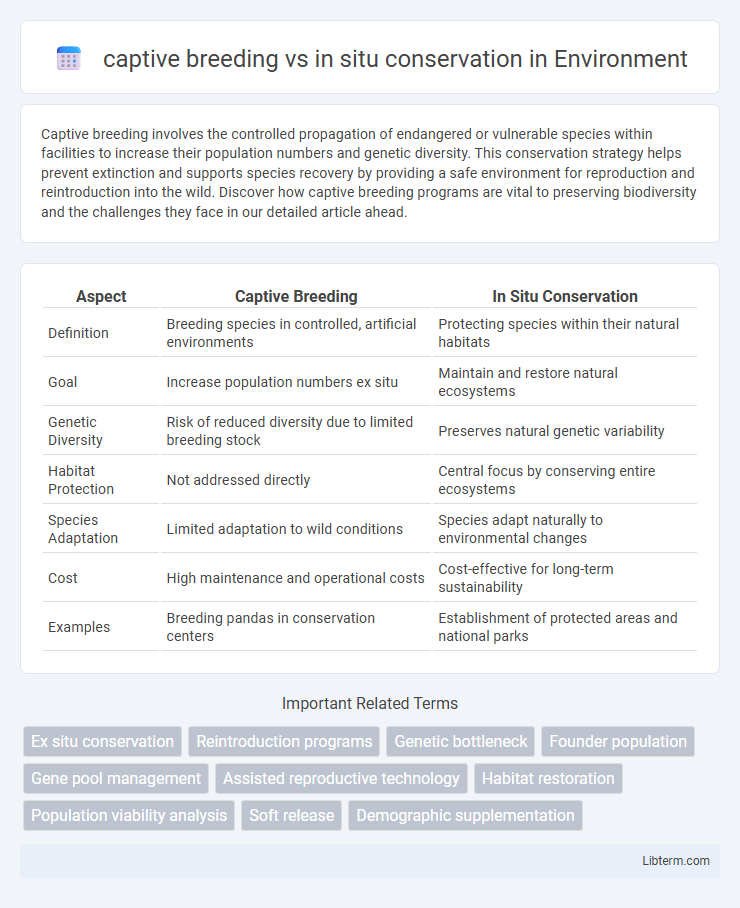Captive breeding involves the controlled propagation of endangered or vulnerable species within facilities to increase their population numbers and genetic diversity. This conservation strategy helps prevent extinction and supports species recovery by providing a safe environment for reproduction and reintroduction into the wild. Discover how captive breeding programs are vital to preserving biodiversity and the challenges they face in our detailed article ahead.
Table of Comparison
| Aspect | Captive Breeding | In Situ Conservation |
|---|---|---|
| Definition | Breeding species in controlled, artificial environments | Protecting species within their natural habitats |
| Goal | Increase population numbers ex situ | Maintain and restore natural ecosystems |
| Genetic Diversity | Risk of reduced diversity due to limited breeding stock | Preserves natural genetic variability |
| Habitat Protection | Not addressed directly | Central focus by conserving entire ecosystems |
| Species Adaptation | Limited adaptation to wild conditions | Species adapt naturally to environmental changes |
| Cost | High maintenance and operational costs | Cost-effective for long-term sustainability |
| Examples | Breeding pandas in conservation centers | Establishment of protected areas and national parks |
Introduction to Conservation Strategies
Captive breeding programs aim to increase population numbers of endangered species in controlled environments, ensuring genetic diversity and preventing extinction. In situ conservation focuses on preserving species within their natural habitats, maintaining ecological processes and biodiversity integrity. Both strategies play complementary roles in comprehensive conservation efforts, balancing immediate species survival with long-term habitat protection.
Defining Captive Breeding
Captive breeding involves the controlled reproduction of endangered species in artificial habitats such as zoos or breeding centers to increase population numbers. This ex situ conservation method contrasts with in situ conservation, which protects species within their natural environments to maintain ecological balance. Captive breeding helps preserve genetic diversity and supports species reintroduction programs when natural habitats are degraded or lost.
What is In Situ Conservation?
In situ conservation involves protecting species within their natural habitats by maintaining and managing ecosystems to support biodiversity. This method preserves the evolutionary processes and ecological interactions vital for species survival. Unlike captive breeding, in situ conservation ensures organisms thrive in their native environments, promoting long-term sustainability and genetic diversity.
Key Differences Between Captive Breeding and In Situ Conservation
Captive breeding involves raising endangered species in controlled environments such as zoos or breeding centers, aiming to increase population numbers before reintroducing them into the wild. In situ conservation focuses on protecting species directly in their natural habitats, preserving ecosystems and ecological processes essential for their survival. While captive breeding provides a safeguard against extinction in the short term, in situ conservation maintains genetic diversity and natural behaviors critical for long-term species sustainability.
Advantages of Captive Breeding Programs
Captive breeding programs offer controlled environments that enhance reproductive success and genetic management, reducing extinction risks for endangered species. These programs facilitate species recovery by allowing population growth away from threats like habitat loss and predation. Captive breeding also supports research on species biology and behavior, improving conservation strategies for reintroduction into natural habitats.
Benefits of In Situ Conservation
In situ conservation preserves species in their natural habitats, maintaining ecological processes and evolutionary dynamics critical for long-term survival. It supports biodiversity by protecting entire ecosystems, allowing species to interact naturally with their environment, which enhances genetic diversity. This approach is cost-effective and sustainable, fostering resilience against environmental changes and human impacts.
Limitations of Captive Breeding
Captive breeding faces limitations such as reduced genetic diversity due to small initial populations and inbreeding risks, which can compromise species' long-term survival. Animals often experience behavioral changes and diminished survival skills, making reintroduction into natural habitats challenging. Financial constraints and the need for specialized facilities further restrict the scalability and effectiveness of captive breeding programs compared to in situ conservation.
Challenges of In Situ Conservation
In situ conservation faces significant challenges including habitat fragmentation, poaching, and environmental changes that threaten species survival within their natural ecosystems. Limited funding and inadequate enforcement of protected area regulations often hinder effective management and biodiversity preservation. Climate change exacerbates these threats by altering habitats and disrupting ecological balances crucial for species adaptation and resilience.
Case Studies: Successful Examples
Captive breeding programs for the California condor have successfully increased population numbers from 27 individuals in the 1980s to over 400 today, demonstrating a key role in species recovery. In situ conservation efforts in Yasuni National Park, Ecuador, preserve critical habitat for endangered species like the Amazonian poison frog by maintaining biodiversity within its natural environment. These case studies highlight complementary strategies where ex situ breeding supports genetic diversity, while in situ conservation ensures long-term ecosystem stability.
Choosing the Right Conservation Approach
Choosing the right conservation approach depends on species-specific needs and habitat conditions, with captive breeding offering controlled environments to boost population numbers of critically endangered species. In situ conservation prioritizes preserving natural habitats and maintaining ecological processes, ensuring species survival within their native ecosystems. Evaluating genetic diversity, threats, and long-term sustainability guides effective integration of captive breeding and in situ strategies for balanced biodiversity conservation.
captive breeding Infographic

 libterm.com
libterm.com